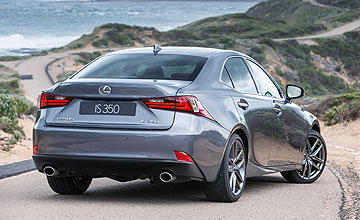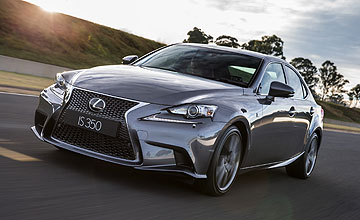Lexus / IS / 350 Sports Luxury

Our opinionPrice and equipment
The $84,000 IS 350 Sports Luxury is the flagship member of the new-generation IS range, at least until a successor to the hi-po IS F emerges (the old version remains available, but is a previous generation version).
The same engine can be had in the IS 350 Luxury from $65,000, or is F Sport guide at $73,000. Both have fewer standard features than the Sports Luxury.
Standard features on the car we tested include a thumping 835-watt, 12 channel and 15-speaker audio system by Mark Levinson, including DAB+ digital radio to take advantage of the growing number of digital stations out there. It is a corker.
Naturally, Bluetooth audio and phone connections are standard, and the expanded voice control system can navigate the infotainment menus, select a song from your iPod or dial phone numbers.
Our car also had heated and cooled leather seats, an adjustable rear wind-shade, dual-zone climate control, rear parking camera with sensors, satellite navigation with live traffic updates displayed on a seven-inch TFT screen, cruise control with radar guidance than slows the car down until it cuts out at 40km/h (many cars can bring the car to a complete halt these days), some nice cabin LED lighting, keyless start and Lexus’ Enform phone app suite.
Interior
Lexus has never struggled with producing interiors of a high quality and packed with lengthy equipment lists, but stylistic nous and surprise-and-delight tactility are perhaps not qualities intrinsically tied to the company’s previous wares.
But then the company up and made the insane LFA supercar, principally to show the world just how sexy and sporty it could be if it tried. But it also trickled down a number of innovations to its more humble offerings.
Take the ‘meter ring’ that slides across like on rails to reveal the multimedia menu in the driver’s instruments when you play with the wheel-mounted buttons. Or the chunky three-spoke leather steering wheel with a massive Lexus logo on the middle.
The Lexus Remote Touch system is a novel take on the established method of placing a dial and some switches on the transmission tunnel to control the instrumentation instead of a fiddly touchscreen. This is because Lexus uses not a dial, but rather a mouse-like toggle.
If you wade through the settings, you can adjust the sensitivity - we set ours to the minimum - and found it to be a bit like operating a laptop’s trackpad.
The ergonomics are spot-on throughout, with the electric seats and steering wheel adjusting in myriad ways for the oddly proportioned among us (yours truly included).
Lexus says the hip point in the new car is lower than before, and from the wheel the IS does feel ‘sporty’. You sit low, with the expansive bonnet stretching out before you. In the rear, things are more spacious than the atrocious previous model - even with a sunroof fitted, there’s adequate leg- and headroom for two adults and a child. Bootspace is a decent 480L, and its long and wide, if a little shallow.
Downsides in here are few and far between. The cruise control stalk is lifted straight from a Toyota Corolla - literally, if you recall which company owns Lexus - and the design of the central fascia is a touch on the slabby side.
Perhaps the most egregious bugbear is the foot-operated parking brake, which in an age of electric or regular hand-operated hydraulic units feels cheap and ungainly by comparison.
Engine and transmission
In an age of punchy diesels and downsized turbo petrols, the IS 350’s 233kW (at 6400rpm) and 378Nm (at 4800rpm) 3.5-litre normally aspirated V6 petrol engine looks a little old-hat. But hold the phone on that thought.
It brings smoothness and refinement to the table: it’s a perfect engine for long and lazy cruising, and a heavy right foot elicits a lovely low and growling bark from the exhausts. And the eight-speed torque converter automatic puts butter to shame for smoothness.
We managed to use around 10.5 litres of 95 RON petrol per 100km over about 600km, which is pretty close to Lexus’s claim, but falls short of the smaller turbos in German rivals. Or, for that matter, Infiniti’s Q50 hybrid.
Ride and handling
The new-gen IS range nudges closer than ever to the BMW 3 Series benchmark, and that’s really saying something.
The electric power steering is suitably light around town but loads up and becomes far more interactive with pace. Turn-is is eager, body control measured and high-speed ride remains generally composed on its firmest setting.
At lower speeds, we noticed a little fussiness to the ride teleported through the 18-inch rims - nothing particularly outlandish, but enough to occasionally disturb the otherwise serene cabin environment.
All IS models have a 10 per cent stiffer (and 10kg lighter) high-tensile steel bodyshell than before, a 15mm wider front and rear track and a 20 per more rigid front stabiliser bar, while the double-wishbone front suspension features slightly softer springs to counteract the stiffer front bar.
The rear multi-link setup features some lightweight aluminium components, while the toe-control arm has been moved to behind the rear axle and the coil spring and dampers have been separated. Lexus says this helps ride comfort.
F Sport and Sports luxury add variable adaptive suspension.
Safety and servicing
Euro NCAP awarded the IS the maximum five stars.
The car comes with eight airbags and a pop-up bonnet that lifts slightly when the car senses an imminent pedestrian impact, thereby cushioning the blow by putting air between a person’s head and the engine cover.
Lexus offers a four-year/100,000km warranty, as well as its Encore Privileges program that gives service customers the choice between a loan car or having their car picked up and dropped off for them.
Verdict
There are no shortage of worthy contenders in the premium mid-sized passenger market. The Audi A4, BMW 3 Series, Mercedes-Benz C-Class and even the newly launched Infiniti Q50 are all excellent options in the $50k-$85k range.
The Lexus IS 350 deservedly sits among them, even if it uses more fuel than its rivals.
Its strengths are the attention-to-detail in its build, the smoothness of its powertrain, its long list of standard features and Lexus’s famed aftersales service. Existing Lexus buyers are likely already interested, but this car has what it takes to lure converts as well.
Rivals
Infiniti Q50 Hybrid S Premium AWD ($73,900 plus ORC). Fellow Japanese premium player Infiniti - yes, the company is based in Hong Kong, but it’s owned by Nissan - should have a hit on its hands with the Q50. The V6 hybrid drivetrain is stonking fast and rather frugal, its handling is top notch and the feature list is long.
BMW 335i (from $93,400 plus ORC). The 3 Series remains a gem, with sportscar handling, a rorty six-pot engine and all the badge kudos you could desire.
Mercedes-Benz C300 ($86,050 plus ORC). Benz’s V6-engined C-Class may be getting long in the tooth - an all-new model emerges in July - but it remains up there with the best. Rival brands would be within their rights to be a little nervous about just how good the next one could turn out to be.

No comments:
Post a Comment